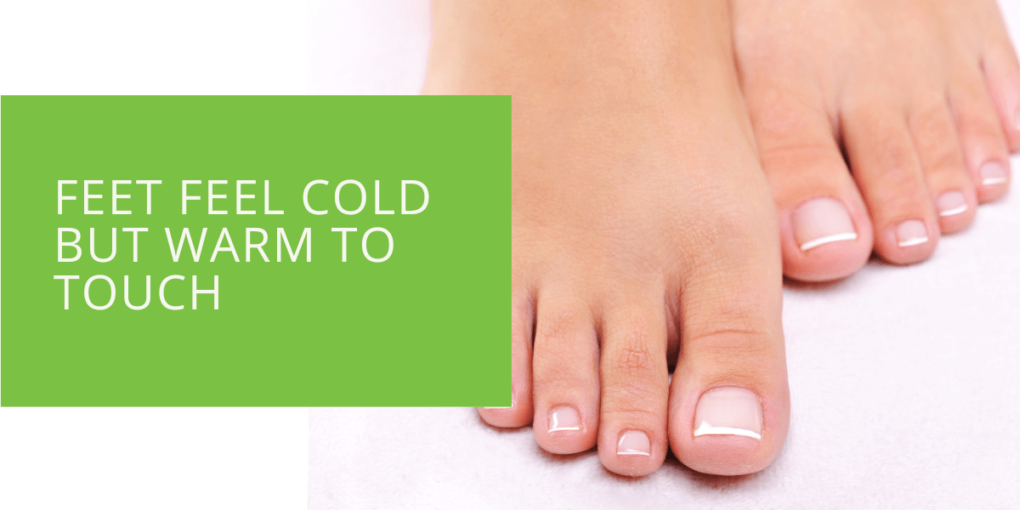Feet Feel Cold but Warm to Touch
Do you often experience the perplexing sensation of your feet feeling cold, despite being warm to the touch? This article delves into the causes and potential solutions for this peculiar symptom. Understanding the underlying factors is crucial for accurate diagnosis and effective treatment. Let's explore the phenomenon of cold feet and unravel its mysteries.
Understanding the Cold Feet Sensation
To comprehend why your feet feel cold while appearing warm to others, it's important to understand the normal regulation of temperature in the feet. Blood circulation and thermoregulation play key roles in maintaining optimal foot temperature. However, certain conditions can disrupt this delicate balance, leading to the perception of cold feet even when physically warm.
Causes of Feet Feeling Cold but Warm to Touch
Feeling cold in your feet while they appear warm to the touch can stem from various underlying factors. Understanding these causes is crucial for accurate diagnosis and effective treatment. Let's explore the potential reasons behind this perplexing sensation:
Poor Circulation: Impaired Blood Flow to the Feet
Poor circulation is a common cause of feet feeling cold despite being warm to the touch. Conditions such as peripheral artery disease (PAD) or Raynaud's disease can restrict blood flow to the extremities, including the feet. PAD occurs when the arteries that supply blood to the legs and feet become narrowed or blocked by fatty deposits, reducing the flow of oxygenated blood. Raynaud's disease is characterized by narrowing blood vessels in response to cold temperatures or stress, leading to decreased blood flow to the fingers and toes. In both cases, inadequate blood supply to the feet can result in a persistent sensation of coldness.
Nerve Damage or Neuropathy: Altered Temperature Perception
Nerve damage or neuropathy can affect temperature perception in the feet, leading to the feeling of coldness. Conditions such as diabetic or peripheral neuropathy can result in nerve damage that disrupts the normal transmission of sensory signals. As a result, the brain may interpret the temperature sensations inaccurately, leading to a mismatch between the actual temperature of the feet and how they feel. Additionally, neuropathy can cause other symptoms, such as numbness, tingling, or a burning sensation in the feet.
Hypothyroidism: Thyroid Dysfunction and Decreased Heat Production
Hypothyroidism, an underactive thyroid gland, can contribute to the sensation of cold feet. The thyroid gland is vital in regulating metabolism, including heat production. In cases of hypothyroidism, the thyroid gland does not produce enough thyroid hormones, which can decrease overall body heat production. As a result, individuals with hypothyroidism may experience feelings of coldness, particularly in the extremities such as the feet. Other symptoms of hypothyroidism may include fatigue, weight gain, dry skin, and hair loss.
Other Contributing Factors: Lifestyle and Medical Conditions
Various other factors can contribute to the sensation of cold feet. Lifestyle choices, such as smoking or exposure to cold temperatures, can affect blood flow and contribute to coldness in the feet. Certain medications, such as those that constrict blood vessels or affect nerve function, may also play a role. Medical conditions like anemia or autoimmune disorders can also impact circulation and contribute to cold feet.
When to Seek Professional Help
If you consistently experience the symptom of cold feet despite appearing warm to the touch, it's important to consult a podiatrist or healthcare professional. Persistent or worsening symptoms and other concerning signs may indicate an underlying medical condition. Seeking professional advice ensures accurate diagnosis and appropriate treatment.

Treatment Options and Management
Addressing Underlying Conditions
Treating underlying conditions is essential for alleviating the symptom of cold feet. Medical interventions and lifestyle changes may be recommended based on the diagnosed condition. For example, managing PAD may involve medications to improve blood flow or surgical interventions in severe cases. Proper management of neuropathy or hypothyroidism can also help improve circulation and temperature regulation.
Improving Circulation
Strategies to enhance blood circulation can help alleviate cold feet symptoms. Regular exercise, particularly activities that promote lower limb circulation, can be beneficial. Avoiding tight footwear that restricts blood flow is important. Keeping feet warm with appropriate socks and footwear, especially in colder environments, helps maintain optimal foot temperature. Foot massages, warm foot baths, or elevating the feet may also promote blood flow and provide temporary relief.
Foot Care and Maintenance
Proper foot care is crucial for overall foot health and can contribute to managing cold feet symptoms. Regularly washing and moisturizing the feet helps maintain skin integrity and prevents dryness. Protecting the feet from extreme temperatures and wearing insulating socks can help retain warmth. Regular foot examinations by a podiatrist or healthcare professional can ensure early detection and management of foot-related health conditions that may contribute to cold feet.
It's important to note that the treatment approach may vary depending on the underlying cause of cold feet. Therefore, professional guidance is essential for an accurate diagnosis and personalized treatment plan. A podiatrist or healthcare professional can conduct a thorough evaluation, consider your medical history, and perform any necessary tests to determine the underlying cause and recommend appropriate interventions.
Conclusion
Experiencing cold feet despite feeling warm to the touch can be perplexing. Poor circulation, nerve damage, hypothyroidism, and other factors can contribute to this sensation. Understanding the underlying causes is crucial for effective management. Seeking professional help is recommended for accurate diagnosis and personalized treatment. By addressing the underlying conditions, improving circulation, and maintaining proper foot care, individuals can find relief from cold feet and enhance overall foot health.

